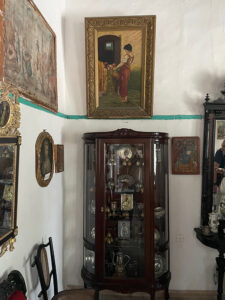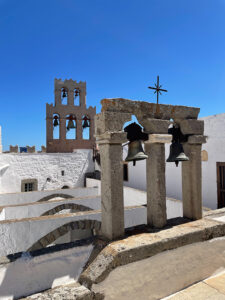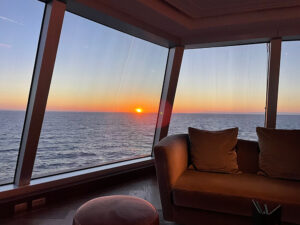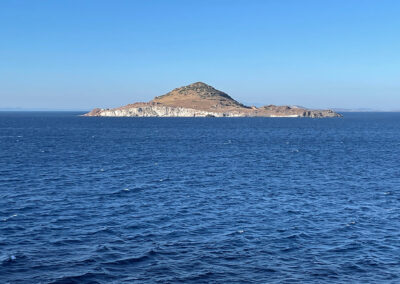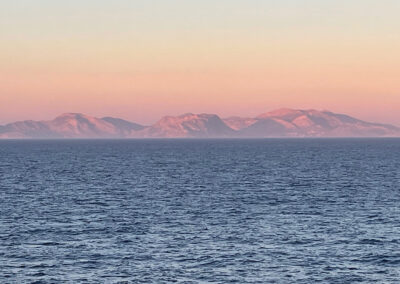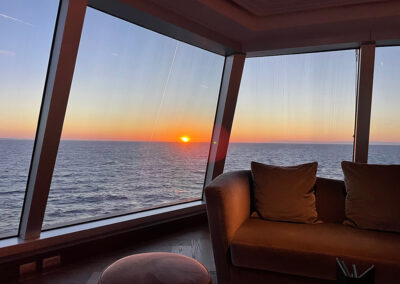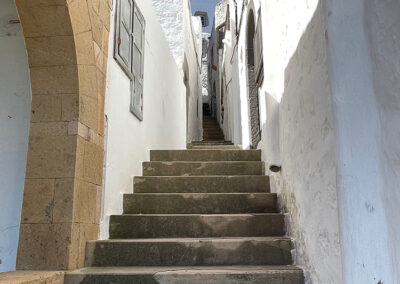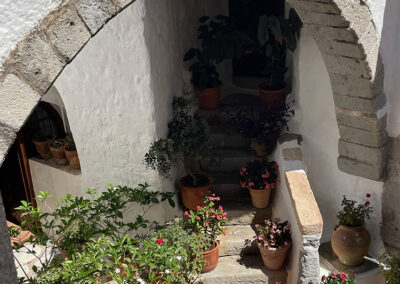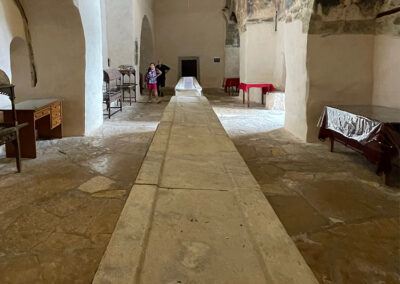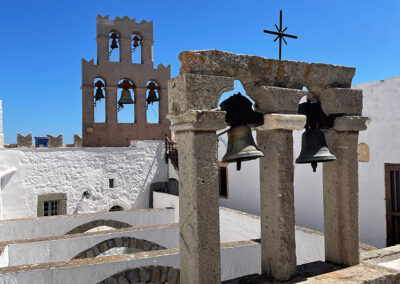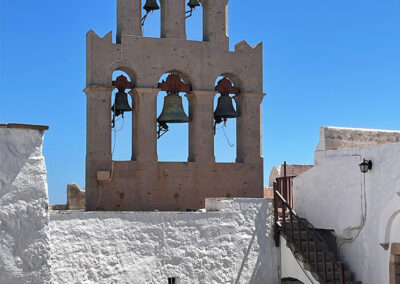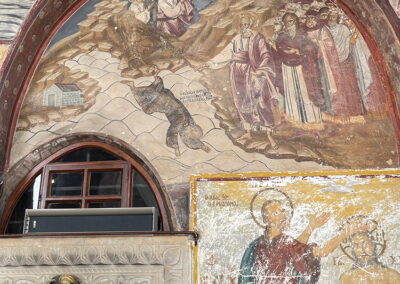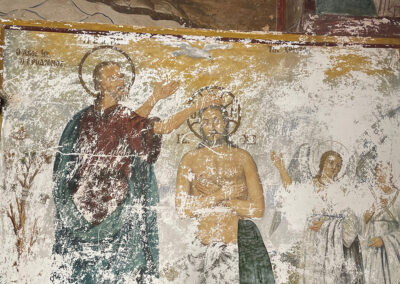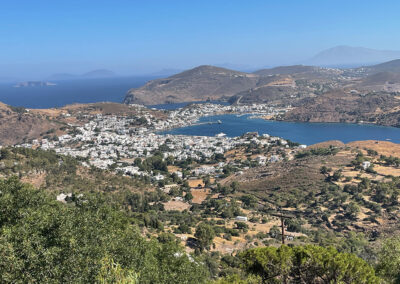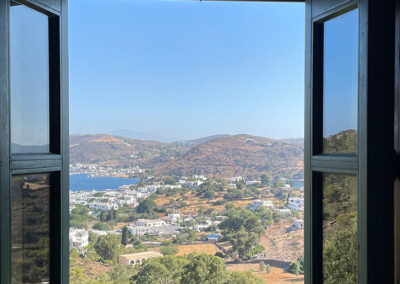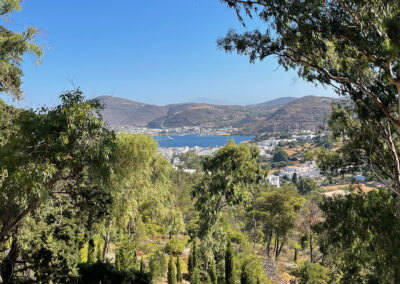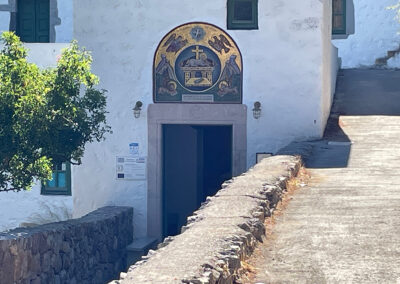Turkey and Greek Islands
Cruising the Aegean
Getting There
Lesbos | Mykonos | Kuşadasi and Ephesus | Patmos | Rhodes | Cyprus | Antalya | Bodrum | Crete
Getting Home
Patmos
On Saturday, June 15, I had an early breakfast and took off on a tender to spend the morning with John the Apostle and his Revelations. The Grandeur was at anchor near the harbor of Skala, on Patmos. John had been exiled there by the Romans and spent a couple of years there. My tour group stopped first just partway up the mountain at the Cave of the Apocalypse. This place has long been considered the place where John had his visions of the end of the world recorded in the book of Revelation. A substantial complex of buildings has been built around the cave, including a little chapel which opens into the cave itself. This is one of the places I vividly remember visiting in 1996.
We entered the building and gathered in an anteroom to the chapel while our guide explained some about the place we would see next. Her explanation outside the little chapel and the cave was good and to the point, and her delivery was fantastic! Goosebumps! We found out later she’s an actress in her other life, has been in scenes in some Netflix shows, and even has some clips of her lines on her phone. Of course, being the self-centered nerd I am, I don’t remember her name.

Skala from the Chapel of the Apocalypse
This time there was an Orthodox priest chanting a service as we gathered inside the chapel. Appropriately I think, photographs were not allowed, and being there during the chanting of prayers and responses from a few people made the visit much more meaningful to me than it did 25 years ago. I sometimes wonder about the authenticity of ancient Christian sites, particularly those from the first century. The Romans wouldn’t have paid that much attention to someone up on the mountain side, and who else was there to remember its significance after John’s death? On the other hand, this place has been recognized as “THE cave” for centuries. It’s hallowed by tradition if nothing else.

Patmos, steps in Hora
When we left this site we went to Hora, another of the three towns on this small island. Hora is at the top of the mountain and is the site of the St. John Monastery and Museum. The bus had a narrow road to follow with more than a few tight turns along the way. It couldn’t get through the narrow streets, and only a few places I saw in the town were on flat ground, so we got our exercise walking up and down hill a lot when we weren’t climbing steps.
The first place we visited was the Mansion of Simantiris, a house built in 1625 that is still in the same family. Today it’s basically a house museum, with no one in residence. It’s filled with antique furniture, memorabilia, and many elements that reminded me of the nineteenth-century furniture and mementos we have at Cook Hill. I was really struck by that when in one room I saw a curved-front china cabinet with what was clearly a nineteenth-century genre painting above it. It might not have been The Roman Girl, but it could have easily been swapped with that one. We had run into that same situation, where elements from places half a world apart were almost identical, when we were in Croatia two years ago. It’s a small world after all, and in that respect we all live in the same place.
It was a bit of a hike, followed by a lot of steps, but we did make it to the Monastery of St. John, literally a mountaintop experience. This was another good visit. We gathered in a small courtyard for an introduction before we entered the really small chapel. The frescoes were really striking, even in their eroded condition. I kept thinking of the parallels to the manuscripts i worked with on my dissertation. Some of the same artistic considerations and approaches were apparent on every wall, since these dated not from antiquity but from the Middle Ages. To me just going this far was worth the climb to get here. The refectory was also a cool place to see, though it has been replaced with a newer dining room for the monks who live there now. There’s a marble table–not a marble-topped table, but a marble table–running the length of the room. Frescoes were scattered around the walls here as well, just not so many as in the chapel.
To me it was a disappointment to find I couldn’t take photographs inside the museum. Their place, their rules. I had another moment of comparison when I realized I was looking at some third-century manuscripts. They were a thousand years older than the Medieval ones I worked with. And lest I give you the wrong idea, there are certainly other items in the museum. I know Judy would have loved seeing some of the elaborate crosses and other bejeweled pieces.
We walked back down the streets and steps to board the busses and have lunch at a restaurant partway back down the mountain. I really love the opportunities like this to sample some local food, even if it is served in a somewhat commercialized context. This time we had local appetizers, a main course, and desserts, all accompanied by local entertainers and local wine. Afterward we got a longer, scenic ride back to Skala, where we boarded local boats instead of the ship’s tender to return to the Grandeur.
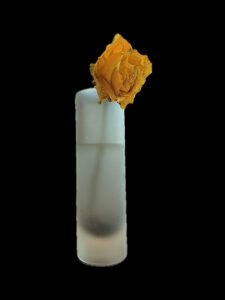
The Dying Rose
That evening we had dinner in Sette Mari, the Italian place that doesn’t require reservations. The food was good, as we expected it to be, but the unintended entertainment was excellent. Judy had noticed a display of wines and cordials in the lobby before we entered the restaurant. We had looked at them, commented on the variety, but didn’t remember names. (Keep that in mind.) That little bit of fun was seconded by the flowers on the tables. There was a dead or dying yellow rose bud in a vase on every table we could see. We still don’t know why. Those same tables were always set with lovely flowers in the same vases when that space served as half of La Veranda for breakfast and lunch. That sort of puzzled amusement was topped off when Judy took the waiter’s arm and escorted him to the lobby. She wanted to try some of the liqueurs, but had to point the bottles out since we didn’t remember names.
After dinner we went to the Observation Lounge and had a relaxing time watching the sunset. Another peaceful and fulfilling day was done.
Photographs
Photographs: Monastery of St. John
Photographs: Chapel of the Apocalypse
Getting There
Lesbos | Mykonos | Kuşadasi and Ephesus | Patmos | Rhodes | Cyprus | Antalya | Bodrum | Crete
Getting Home


